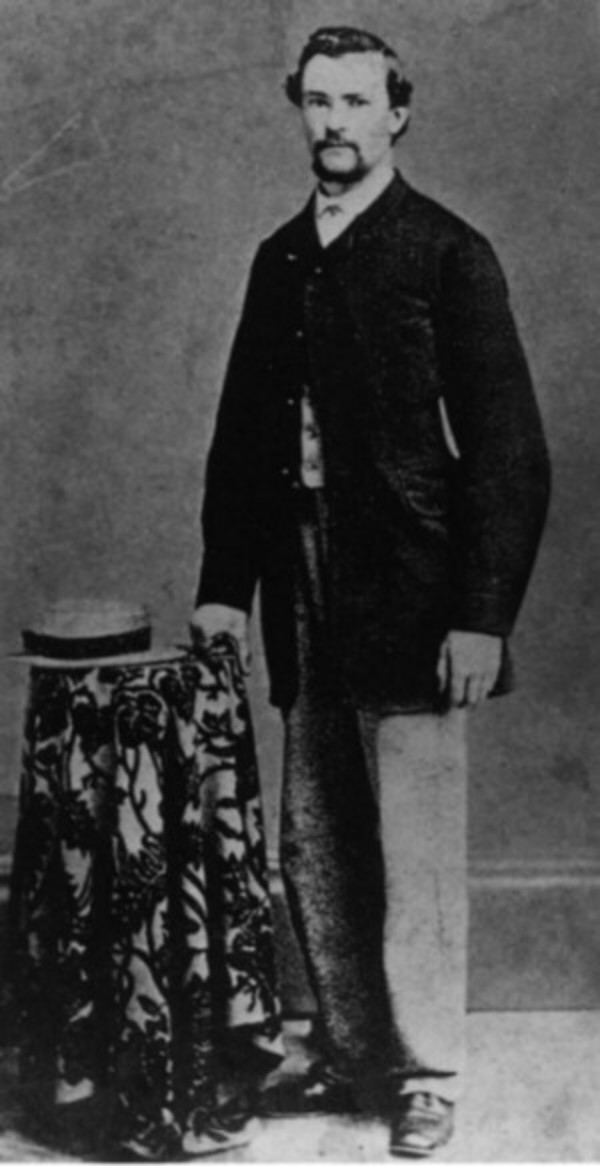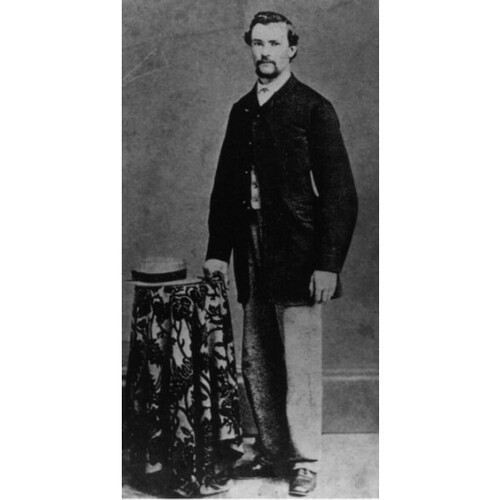As part of the funding agreement between the Dictionary of Canadian Biography and the Canadian Museum of History, we invite readers to take part in a short survey.

Source: Link
MATTHEW, GEORGE FREDERIC, office holder, geologist, palaeontologist, curator, and author; b. 12 Aug. 1837 in Saint John, son of George Matthew and Deborah Eliza Harris; m. 15 April 1868 Katherine Mary Diller in Brooklyn (New York City), and they had six sons and two daughters; d. 14 April 1923 in Hastings-on-Hudson, N.Y., and was buried in Gondola Point, N.B.
George Matthew lived in Saint John at a time when the city was a busy port and an important centre in eastern Canada. He attended the Saint John Grammar School and entered public service on 1 May 1853 as a clerk in the provincial Treasury Department, which merged with the federal Department of Customs after confederation. He would be appointed chief clerk of the Saint John customs service on 28 May 1879 and surveyor of customs on 1 July 1893, a position he held until his retirement in 1915. His friends believed that but for political considerations he would have been made collector of the port.
Even though Matthew did not attend university, the intellectual atmosphere in Saint John supported his interest in natural history, and its complicated geology challenged his curiosity. In 1857, at age 20, he helped found the Steinhammer Club, comprised of five young men interested in local geology. They were possibly inspired by the presence of Abraham Gesner*’s geological collection in the museum of the Mechanics’ Institute. Matthew entered on the study of New Brunswick geology at an opportune time. John William Dawson* was then preparing a revised edition of his Acadian geology . . . (1855), which was to include New Brunswick. Dawson became interested in the Steinhammer Club, especially the work of Matthew and Charles Frederick Hartt*, who provided information used in his revision (1868) and in earlier papers on the Carboniferous and Devonian flora of New Brunswick. As Canada’s foremost geologist, Dawson likely had considerable influence on Matthew. At his suggestion, the Natural History Society of New Brunswick (NHSNB) was established in Saint John in 1862. A charter member, Matthew became the society’s first curator.
Soon after, Matthew’s friend Professor Loring Woart Bailey of the University of New Brunswick began geological mapping of the province with the assistance of Matthew and Hartt. Following confederation the Geological Survey of Canada extended its operation to the Maritimes, and in 1868 its director, Sir William Edmond Logan*, met with Bailey and Matthew to discuss the work. Between 1864 and 1880 Matthew, jointly with Bailey or with Bailey and GSC geologist Robert Wheelock Ells, published numerous reports and maps on New Brunswick geology. Matthew would work as a temporary palaeontologist for the GSC until 1901, occasionally recovering expenses and supplementing his salary. In addition to preparing reports, he acted as the survey’s expert in Cambrian geology, assisting in the identification and classification of Cambrian specimens and in the arrangement of the GSC’s museum.
In 1882 the NHSNB, which had been moribund for some years, started publishing a Bulletin. Matthew paid for the printing of the second number and became a regular contributor. That same year the Royal Society of Canada began meeting in Ottawa. Dawson, its first president, selected Matthew as one of the charter members representing the geological and biological sciences. In 1889 Matthew became president of the NHSNB, an office he held until 1895 (when he was succeeded by George Upham Hay*), and in 1891–92 he was president of his section of the RSC. He published over 200 papers and corresponded with geologists across North America, Britain, and Europe. His first paper, in the Canadian Naturalist and Geologist (Montreal) for 1863, reported on the geology of Saint John County. His writings were mostly descriptive accounts of new species; however, he also contributed papers synthesizing regional geology. His interests ranged from Quaternary climate and archaeology to Precambrian palaeontology. Although at the time religion strongly influenced geologists, Matthew, an Anglican, did not mention religion or Darwinism in his writings, as Dawson often did.
Saint John’s complex geology provided a lifetime of research. Within miles of home were Precambrian stromatolites, for which in 1890 Matthew provided the first scientific description. From local Cambrian shales, he was among the first palaeontologists to recognize a sub-trilobitic interval in the Lower Cambrian. In 1899 he summarized the “Etcheminian series” and accurately described small shelly fossils. Although American palaeontologist Charles Doolittle Walcott prevailed in dismissing the Etcheminian and included these fossils in his Lower Cambrian series, areas where the Etcheminian was originally recognized provide a standard reference for Cambrian correlation. Nearby at “Fern Ledges” Matthew studied fossil plants, insects, and trackways. After a Carboniferous age was established for these rocks, Matthew argued that fossil interpretations needed revision since the stratigraphy necessitated a Devonian age. His claim illustrated his devotion to the earlier work of Dawson and Bailey. Bailey said that Matthew, in his eighties, still determined to prove an older age for these rocks, walked the Bay of Fundy coastline to Maine to relate his observations to those made by American geologists.
By the 1890s Matthew had made himself a well-established member of the geoscience community, although still an amateur. The Université Laval conferred a dsc on him in 1894 and the University of New Brunswick bestowed two honorary degrees, ma in 1878 and lld in 1897. In 1917 Matthew was awarded the Murchison Medal by the Geological Society of London.
Matthew devoted much time to research, but also to the NHSNB. In his first year as president he served on standing committees for geology, the library, essays and lectures, publications, the meeting hall, and the press – a typical commitment for him. He also enriched the museum through the collection and exchange of specimens. His wife, Katherine, was a long-time president and active member of the society’s ladies’ association. Their eldest son, William Diller, often accompanied his father in the field and became a famous vertebrate palaeontologist at the American Museum of Natural History in New York.
Matthew described more than 350 new species of fossil plants and animals. Although his work has been revised, much remains valid and attests to his excellence as a scientist with a keen sense of observation and an untiring spirit. He died in 1923 at William’s home in Hastings-on-Hudson, where he and Katherine had gone to live two years before.
A listing of over 200 of Matthew’s publications appears in Ed Landing and R. F. Miller, “Bibliography of George Frederick Matthew,” New York State Museum, Bull. (Albany), 463 (1988): 77–80, and about 150 in Science and technology biblio. (Richardson and MacDonald). His writings include “Sketch of the history of the Natural History Society of New Brunswick,” N.B., Natural Hist. Soc., Bull. (Saint John), no.30 (1912): 457–74.
New Brunswick Museum (Saint John), F1, item 1-5 (H. Ami to G. F. Matthew, 27 Jan. 1888) G. F. Matthew corr., esp. G. M. Dawson to Matthew, 11 Jan. 1898 and 23 May 1900. Daily Telegraph and the Sun (Saint John), 8 Oct. 1921. Saint John Globe, 30 April 1903; 8 Oct. 1921; 18, 21 April, 12 May 1923. St. John Morning Telegraph (Saint John), 21 April 1868. L. W. Bailey, “George F. Matthew,” RSC, Trans., 3rd ser., 17 (1923): vii–x. W. D. Matthew, “Memorial of George F. Matthew,” Geological Soc. of America, Bull. (New York), 35 (1924): 181–82. R. F. Miller, “George Frederic Matthew (1837–1923),” in Trace fossils, small shelly fossils and the Precambrian–Cambrian boundary: proceedings, August 8–18, 1987, Memorial University, ed. Ed Landing et al., New York State Museum, Bull. (Albany), no.463 (1988): 4–7; “George Frederic Matthew: Victorian science in Saint John,” NBM News (Saint John), August–September 1987: 1–28. R. F. Miller and D. N. Buhay, “Life and letters of George Frederic Matthew: geologist and palaeontologist: an annotated list of Matthew’s geological correspondence in the New Brunswick Museum library and archives,” N.B. Museum, Pubs. in Natural Science (Saint John), no.8 (1990); “The Steinhammer Club: geology and a foundation for a natural history society in New Brunswick,” Geoscience Canada (St John’s), 15 (1988): 221–26.
Cite This Article
Randall F. Miller, “MATTHEW, GEORGE FREDERIC,” in Dictionary of Canadian Biography, vol. 15, University of Toronto/Université Laval, 2003–, accessed March 29, 2025, https://www.biographi.ca/en/bio/matthew_george_frederic_15E.html.
The citation above shows the format for footnotes and endnotes according to the Chicago manual of style (16th edition). Information to be used in other citation formats:
| Permalink: | https://www.biographi.ca/en/bio/matthew_george_frederic_15E.html |
| Author of Article: | Randall F. Miller |
| Title of Article: | MATTHEW, GEORGE FREDERIC |
| Publication Name: | Dictionary of Canadian Biography, vol. 15 |
| Publisher: | University of Toronto/Université Laval |
| Year of revision: | 2005 |
| Access Date: | March 29, 2025 |



